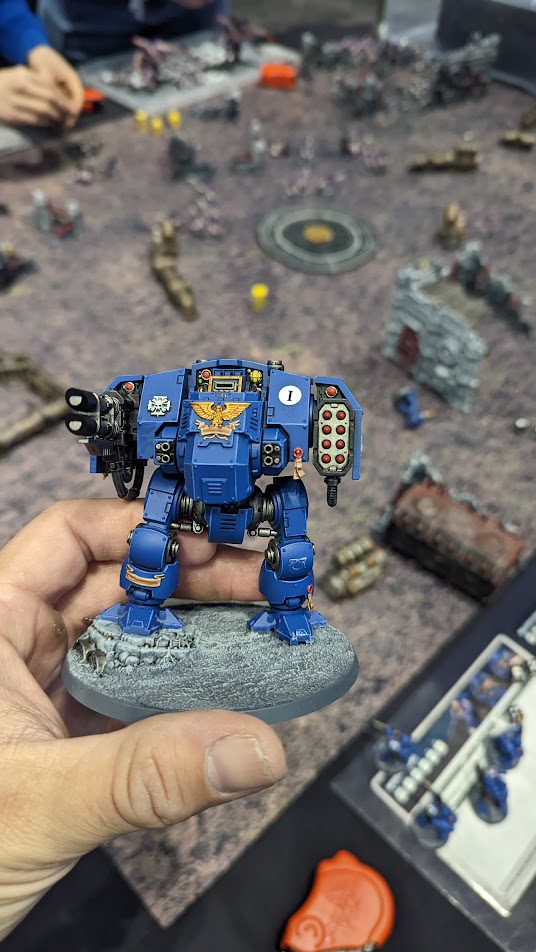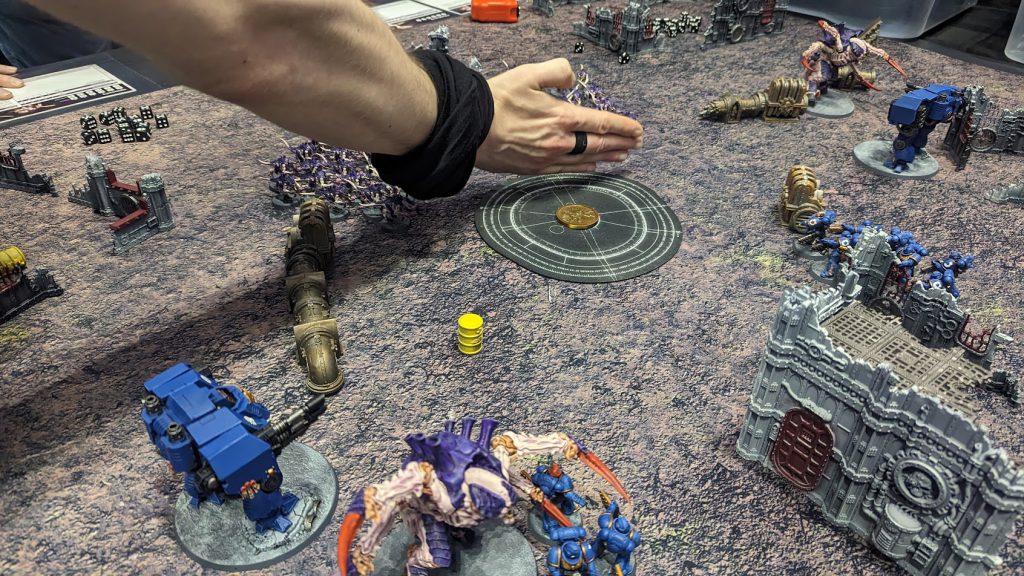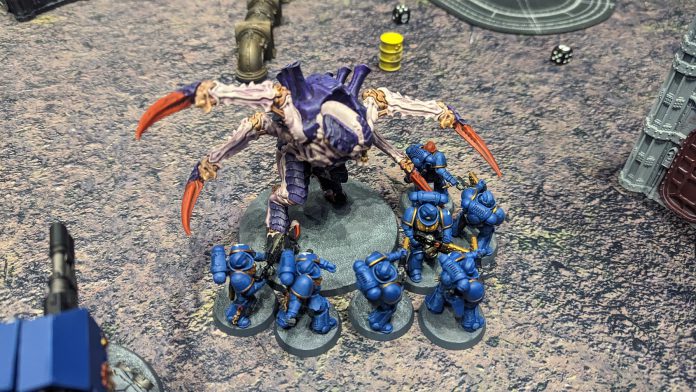Mike Bettle-Shaffer wasn’t the only Goonhammer contributor with the fortitude to survive the 3-hour queues for the 10th edition preview: “Contemptor” Kevin Stillman also managed to make the trip together with one of our Patrons, and brought back not only some thoughts, but a quick battle report for you to get a taste of how the game will actually play on the table!
On Monday Morning, the last day of Warhammer Fest, I woke up early, worked out, and afterwards felt extremely warm. The only way to really remedy this discomfort was to spend two hours outside in Manchester starting the daily entry queue. I had one goal: do the 10th Edition Demo. I would need to be one of the first forty people to make it to the 10th queue, because I would not have time to wait in it.
My persistence paid off, and with a successful advance roll I was able to get my way into the first round of demos. Myself and Goonhammer Patron Yvonmukluk were on a team together commanding the new 10th Edition starter Marines – Yvonmukluk took the Infernus Marines and I took the Ballistus Dreadnought. The Demo was presented by Warhammer TV Presenter Ben!

BATTLE REPORT – 10TH EDITION DEMO
The table was set up with a total of eight units – two Screamer Killers, two Termagant Swarms, two squads of Infernus Marines, and two Ballistus Dreadnoughts. The Tyranids had first turn.
This Demo game was extremely simplified – no CP, no stratagems, no detachment abilities. You got to use what was on the card and some of the publicly-released rules.
Tyranid Turn
Movement Phase:
The Tyranid players advanced their Termagant Swarms, while the Screamer Killers moved forward with a Normal Move.

Shooting Phase:

The Screamer-Killers both fired their plasma barf ability at the Infernus Marines. This was d6+3 attacks (and I think the result this time was a total of six) at a respectable strength 8 with AP -2. After saves, this barf only did one damage to the Marines we were using, but did force a Battleshock test. As our units were Ld 6+, we needed a six or higher on the test.
Both units of Infernus Marines then promptly failed those Battleshock tests.
The Termagants fired a bunch of strength 5 shots, but at AP 0 none of them made it through to hurt the Marines.
In the Charge Phase, the only units within charge distance were the Screamer Killers. The Screamer-Killer near Yvonmukluk and me made its charge…into his Infernus Marines. Thankfully, the other Screamer-Killer did not. One important changed we noticed here was that, while engagement range is still 1″, charging in this new edition requires base-to-base contact if you can make it, or as close as possible if the bits overhanging the model prevent it.

In combat, the Screamer-Killer had 10 strength 10 attacks at AP-2, each of which came in at 3 damage and hit with WS 3+. Terrifying, right? While I didn’t see the specific dice rolls, I do recall my partner having to make 5 5+ saves and only failing two – so only three Marines died to the Screamer-Killer. On the hit-back, Yvonmukluk had 21 normal Space Marine attacks. He scored a ton of his hits, but against a monster with toughness 9 he only managed two wounds, both of which were easily saved.
Marine Turn
Both Infernus units passed their battle-shock tests at the top of the round, but one was stuck in combat, the other Infernus player wanted to roast Termagants.

I moved my Ballistus Dread into position just behind the Screamer Killer locked in combat. While there will likely be stratagems and other rules allowing you to disengage and shoot (Editor’s Note: Like the Combat Doctrines detachment rule recently previewed on Warhammer Community), those were not available to us for this demo, so Yvonmukluk pretty much could only leave his dudes in combat.

In the shooting Phase, I got a chance to try out the mighty new Ballistus Dreadnought. I aimed the Ballistus lascannon, which delivers 2 attacks at an impressive strength 12 and AP-3, at the Screamer-Killer that wasn’t locked in combat. I then aimed the Ballistus missile launcher’s frag missiles and storm bolter at the Termagants. This Dreadnought had the Ballistus Strike ability, which allows it to reroll hits whenever it’s targeting a unit above half strength. Against the Screamer Killer, this meant I was able to hit the Killer twice and wound it both times. It promptly failed both of its saves, and so I was able to punch through seven wounds.
Against the Termagants I rolled an 8 for attacks on 2d6 – but the frag had the blast rule. This meant that for every five models in the unit, I added an additional attack. Against a 20-bug unit of Termagants, this meant I was shooting 12 dice and rerolling hits. All 12 hit, and at strength 5, 10 of them wounded. The bugs only have a 5+ save, and so 7 left the table.
I was then able to put down 4 storm bolter shots – this time with full hit rerolls because the Termagants were above half strength and full wound rerolls from the weapon’s Twin-Linked rule. This took another three bugs off the table.
While I didn’t charge my Ballistus at the undamaged SK, the other player charged his into the one I had damaged earlier. But the stomping feet of a Ballistus only bring 5 attacks at strength 7 with no AP. Unsurprisingly, this wasn’t enough to finish off the toughness 9 Screamer-Killer, but its return attacks were sufficient to kill the Ballistus, which exploded, but not with enough force to take out the Screamer-Killer.

That meant the conclusion of the battle round, at which point our preview ended.
Impressions
The first taste of 10th Edition has left me wanting more. The guns on the Ballistus felt powerful – not powerful enough to be overwhelming without a little favor from the dice gods, but enough to make it feel like I was able to take out a non-trivial amount of the opponent’s force with some good rolls. Likewise–and even more importantly–everything felt tough, but not unfairly tough. Everything in this demo game was forcing 5+ saves when shooting what seemed to be their “intended” targets – the ‘gants had to roll well against a lot of dice, the Screamer-Killer had to get lucky to not get vaporized, and the Marines felt like they were a little out of their depth against a giant monster. I thought it was fun and balanced. Had the Marines the first turn, they could have shot the other side clear off the board, but would have needed a fair a bit of luck to do so.
The layout of the data cards was likewise very nice and easy to read. What I’m personally hoping for is that the App will offer the ability to print out the data cards for a tournament list so you can have an easy reference in the game.
My concern at this point is probably going to be later in the edition: if weirder lists like Greggles’ “Trust in Rust” Deff-Dread mob are viable for army building, that could have a skew effect similar to what March of the Ancients armies have in Horus Heresy. One question is whether the Invulnerable Save that seems to permeate every unit card in 9th Edition 40K is going to rear its ugly head in 10th Edition, leaving us looking at the return of the Crusher Stampede.
Command Phase and Battle-shock
While this wasn’t fleshed out terribly well under the one-round scenario we played, Objective Control was discussed. In order to apply Objective Control, the model must be within 3″ of the 40mm objective marker. And it’s applied model-by-model: a Marine wholly within the 3 inch zone and one merely “toed-in” would each apply their OC to determine who controls the point, but if another model in the squad was wholly outside 3″, that model wouldn’t count.
One question that did come up was whether point scoring happened in the command Phase before or after the battle-shock Test. We didn’t get a clear answer on that, as it was outside the scope of the preview, but our guide’s comments suggested points would be scored at the end of a turn and before the battle-shock test happened.
This matters because a unit that has its OC reduced to zero for battle-shock does not count for objective control. You could have a full squad of Deathwing Terminators in the objective zone, but if they’re battle-shocked a single non-attle-shocked Zephyrim model would be able to swoop in and steal the objective. In sum, Objective Control is on a per-model basis, but battle-shock is on a per-unit basis and can cause you to completely lose objective control.
After I played my demo game and flew back to the United States, Warhammer Community previewed Guilliman’s datacard. One of his mighty Primarch abilities allows nearby units to…reroll battle-shock tests. To me, this suggests that, at least early in this edition, rerolling failed battle-shock tests is going to be a rare thing. Given that battle-shock is a much easier mechanism to understand and apply than morale ever was (and that every faction basically ignored morale except the Guard), this suggests a very new and interesting way to play. Infernus Marines in a Drop Pod seem pretty spicy in this regard!
Final Thoughts
After this preview, I’m very excited to try a full game of 10th. I think there’s a good set of core rules from what we’ve seen so far. The abilities and stats I saw feel powerful, but not too much so. The design philosophy with reining in AP feels like it’s giving agency (or the blessing of the dice gods) to the players in a way that seems absent from 9th. Some things–particularly regarding changes to the charge and fight phase–feel like they’re sensible changes with the upside of profoundly limiting weird movement tricks that frequently catch out new players. This is something I’ll go into in more detail in a future article article.
Also, we need to talk about the queue. That was Not Ok.
Thanks again to Kevin for taking the time to play through the game and write it up. Be sure to check back later for more from Kevin on the rest of what was going on at Warhammer Fest, just as soon as he gets home and gets over the jet lag from his trip.
Got questions for Kevin about his game, or want to comment on something? Hit the comments section below, or drop us a line at contact@goonhammer.com


